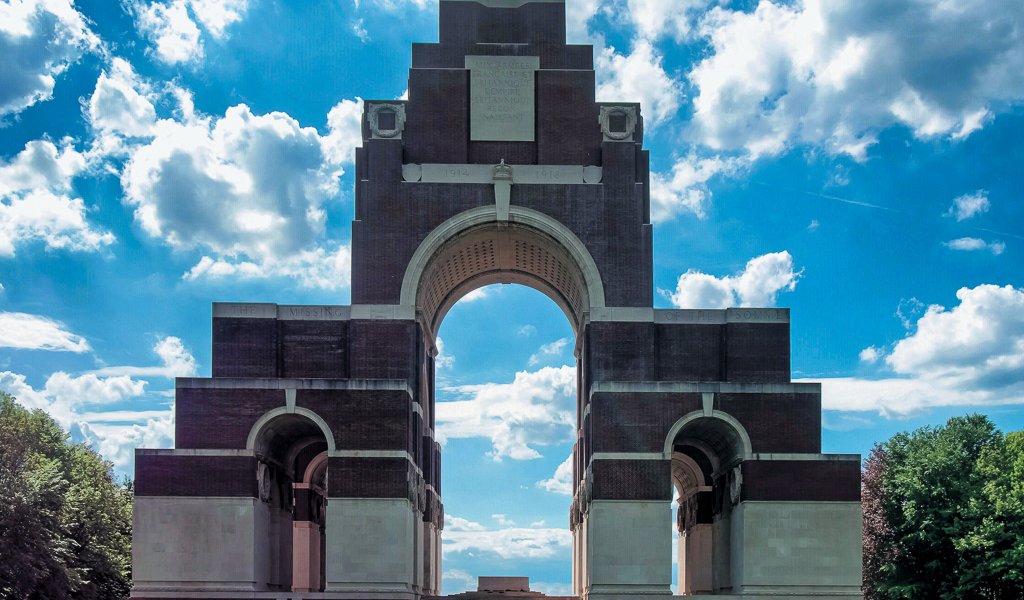During World War One, men who had once graced the football field for Chesterfield came together again, this time on the battlefield. Helen Shepherd finds out more about some of those who swapped their kits for khaki as part of the famous Footballers’ Battalion.
THE first day of the Battle of the Somme, on July 1, 1916, is remembered as the most disastrous day in British military history. Yet after this catastrophic start, the battle would drag on for five more months, involving three million men and resulting in around 420,000 British and Commonwealth casualties. Among them were members of the 17th Battalion of the Middlesex Regiment, known as the Footballers’ Battalion.
At the start of the war, clubs had argued that football should continue as a way of boosting morale. Public opinion did not agree, however, and keeping young, fit men away from the front line soon became impossible to justify. The Footballers’ Battalion was formed at the end of 1914 as part of the famous ‘Pals’ initiative and by March 1915 it was at full strength, made up of around 200 professionals as well as amateur players, club staff, officials and even fans.
At least nine men who played for what was then Chesterfield Town FC were members of the Battalion. These included forward Adrian ‘Haydn’ Green, who joined Chesterfield from Nottingham Forest in the 1909/10 season; Albert Holmes, who made more than 50 appearances for the club; Charles Bell, who scored 11 goals in seven appearances and later went on to manage in England, France, Portugal and Italy; and goalkeeper Joseph Orme.
Another keeper who was part of the Battalion was Percy Summers. Summers joined Chesterfield in 1910 and made an impressive 136 appearances before his departure in May 1914, at the time a record for any goalkeeper at a Chesterfield team. Born Philip Somerville in Sheffield, he initially joined the army in 1908 but deserted a year later. He arrived in Chesterfield in 1910 to begin his playing career, becoming a crowd favourite and an ever-present for two of his seasons at the club.
Despite his previous military record he enlisted again in February 1915 and was in France by the end of that year. In March 1916 he was wounded in the left hand and abdomen by a grenade and was moved out of the front line before being discharged. Amazingly he managed to resume his career and played on until the 1920s. He died in Derby in 1966.
Two more members of the Battalion with links to Chesterfield also had their war ended by injuries. Derbyshire-born right-back Joe Kirkwood joined up on 16 December 1914, just one day after the Battalion was formed. By that time playing for Fulham, he had spent a few months at Chesterfield in 1910. He went to France in November 1915, at the same time as Percy Summers, but was declared medically unfit almost immediately due to a knee injury, possibly picked up playing football. He was discharged in 1916 and died in 1966 in Mansfield.
Charlie Bunyan’s association with Chesterfield went back even further. He played his first game for the club in 1886 at the age of 17 before moving on to Hyde and then Derby County and Sheffield United. Returning to Chesterfield in 1892 he stayed for only a season, after which his career took him to various clubs as player and manager. By 1915 he was at Standard Liege in Belgium but escaped back to England along with his three sons. All four promptly signed up for the army. Charlie, who was now 46 years old, knocked eight years off his age to enlist in the Footballers’ Battalion.
Bunyan was promoted to Lance Corporal and posted to France with the rest of the Battalion in November 1915 but his stay was short-lived. By December he was in hospital suffering from headaches and pains in his back and limbs. In March 1916 he was sent home and later permanently discharged, his real age now known. His military record describes him as “debilitated and tremulous” and “prematurely aged”. After the war he returned to Belgium as a coach but died there in 1922 aged just 53, the effects of his war service almost certainly a factor in his early death.
Whatever these three men felt about their military service being cut short it ensured that they were out of the firing line by the summer of 1916 when the Somme offensive began.
Although the Footballers’ Battalion had been held back from action on that terrible first day they were soon thrown into combat at Delville Wood. Fighting there was Billy Gerrish, a Bristol-born inside right who had joined Chesterfield in the 1912-13 season. On 8 August he was fatally wounded as the Battalion attacked the village of Guillemont. Gerrish’s legs were shattered by an exploding shell; one witness remembered him calmly smoking a cigarette as he waited for stretcher bearers to arrive. Sadly he died of his wounds, aged 27. His body was never recovered and he is commemorated on the Thiepval Memorial.
As the Somme offensive stuttered to a close in November 1916 there was still time for the battle to claim the life of another Chesterfield player. Former miner Joe Smith had joined the club for the 1914/15 season, making 30 appearances. With the Battalion he took part in the assault on Redan Ridge on 13 November, close to the village of Serre in France. Despite being wounded during the attack Sergeant Major Smith, as he had become, was reported to have “again dashed into battle, only to be shot down”. He died aged 27, just five days before the end of the Somme campaign. He is buried at the military cemetery in Serre.
A memorial to the men of the 17th Middlesex and its sister regiment the 23rd (the 2nd Footballers’ Battalion) stands in Longueval, France, close to Delville Wood. The inscription, a quote from the Battalion’s commanding officer, reads: “I would go anywhere with such men. Their esprit de corps was amazing. This feeling was mainly due to football – the link of fellowship which bound them together.”
Editor’s Note: The author gives special thanks to Stuart Basson at Sky is Blue for the player information.






